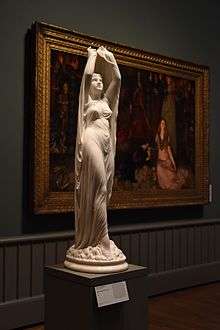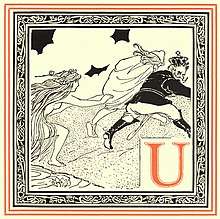Undine
Undines /ˈʌndiːn, ʌnˈdiːn/ (or ondines) are a category of elemental beings associated with water, first named in the alchemical writings of Paracelsus. Similar creatures are found in classical literature, particularly Ovid's Metamorphoses. Later writers developed the undine into a water nymph in its own right, and it continues to live in modern literature and art through such adaptations as Hans Christian Andersen's "The Little Mermaid" and the Undine of Friedrich de la Motte Fouqué.
Undines are almost invariably depicted as being female, and are usually found in forest pools and waterfalls. The group contains many species, including nereides, limnads, naiades and mermaids. Although resembling humans in form, they lack a human soul, so to achieve mortality they must acquire one by marrying a human. Such a union is not without risk for the man, because if he is unfaithful, then he is fated to die.
Etymology
Undine is a term that appears in the alchemical writings of Paracelsus,[2] a Renaissance alchemist and physician. It is derived from the Latin word unda, meaning "wave", and first appears in Paracelsus' book Liber de Nymphis, sylphis, gnomes et salamandris et de caeteris spiritibus, published posthumously in 1658.[3] Ondine is an alternative spelling,[4] and has become a female given name.[5]
Elementals
Paracelsus believed that each of the four classical elements – earth, water, air and fire – is inhabited by different categories of elemental spirits, liminal creatures that share our world: gnomes, undines, sylphs and salamanders respectively.[6] He describes these elementals as the "invisible, spiritual counterparts of visible Nature ... many resembling human beings in shape, and inhabiting worlds of their own, unknown to man because his undeveloped senses were incapable of functioning beyond the limitations of the grosser elements."[7]
Description and common attributes

Undines are almost invariably depicted as being female, which is consistent with the ancient idea that water is a female element.[8] They are usually found in forest pools and waterfalls,[9] and their beautiful singing voices[10] are sometimes heard over the sound of water. The group contains many species, including nereides, limnads, naiades, mermaids and potamides.[8]
What undines lack, compared to humans, is a soul. Marriage with a human shortens their lives on Earth, but earns them an immortal human soul.[11]
The offspring of a union between an undine and a man are human with a soul, but also with some kind of aquatic characteristic, called a watermark. Moses Binswanger, the protagonist in Hansjörg Schneider's Das Wasserzeichen (1997), has a cleft in his throat, for instance, which must be periodically submerged in water to prevent it from becoming painful.[12]
Origins
The ancient Greek philosopher Empedocles (c. 490 – c. 430 BC) was the first to propose that the four classical elements were sufficient to explain everything present in the world.[13] The philosophy of nature spirits was also familiar to the ancient Egyptians and Greeks, and certainly to Paracelsus.[14] Celtic languages scholar Henry Jenner has argued that the elementals grew out of the folklore that preceded them:
The subdivisions and elaborations [of nature spirits] ... by Paracelsus, the Rosicrucians, and the modern theosophists are no doubt amplifications of that popular belief in the existence of a race, neither divine nor human, but very like to human beings, who existed on a "plane" different from that of humans, though occupying the same space which ... resembles the theory of these mystics in its main outlines, and was probably what suggested it to them.[15]
David Gallagher argues that, although they had Paracelsus as a source, 19th and 20th-century German authors found inspiration for their many versions of undine in classical literature, particularly Ovid's Metamorphoses, especially given the transformation of many of their undines into springs: Hyrie (book VII) and Egeria (book XV) are two such characters.[16]
Cultural references

Later writers embellished Paracelsus' undine classification by developing it into a water nymph in its own right. The romance Undine by Friedrich de la Motte Fouqué, published in 1811, is based on a passage in Paracelsus' Liber de Nymphis in which he relates how an undine can acquire an immortal soul by marrying a human,[17] although it likely also borrows from the 17th-century Rosicrucian novel Comte de Gabalis.[18]
Ondine was the title of one of the poems in Aloysius Bertrand's collection Gaspard de la Nuit of 1842. This poem inspired the first movement of Maurice Ravel's 1908 piano suite Gaspard de la nuit.
The character of Mélisande from Maurice Maeterlinck's symbolist play Pelléas et Mélisande has been seen as an Undine figure. Debussy, Sibelius, Fauré, and Schoenberg all wrote music adaptions of the play.[19][20][21] The 1939 play Ondine by French dramatist Jean Giradoux is also based upon Fouqué's novella,[22] as is Ondine, a ballet by composer Hans Werner Henze and choreographer Frederick Ashton[23] with Margot Fonteyn as Undine.[24] Austrian author Ingeborg Bachmann, a friend of Henze's who collaborated with him frequently, attended the premiere of the ballet in London, and published her short story "Undine geht" in the collection Das dreißigste Jahr (1961),[25] in which Undine "is neither a human nor a water spirit, but an idea".[24]
Fouqué's Undine also exerted an influence on Hans Christian Andersen's "The Little Mermaid" (1837),[26][27] and H.D. plays on this identification in her autobiographical novel HERmione (1927).[28][29] Burton Pollin notes the popularity of the tale in the English-speaking world: translations in English appeared in 1818 and 1830, and a "superior version" was published by American churchman Thomas Tracy in 1839 and reprinted in 1824, 1840, 1844, and 1845; he estimates that by 1966 almost a hundred English versions had been printed, including adaptations for children. Edgar Allan Poe was profoundly influenced by Fouqué's tale, according to Pollin, which may have come about through Poe's broad reading of Walter Scott and Samuel Taylor Coleridge:[30] Scott had derived the character of the White Lady of Avenel (The Monastery, 1820) from Undine,[31] and a passage by Coleridge on Undine was reprinted in Tracy's 1839 edition.[30]
Japanese pianist Yukie Nishimura composed a piece of piano music in the title of Undine in late 1980s.
The composer Carl Reinecke wrote the "Sonata Undine" for flute and piano, opus 167, first published in 1882.
The Filipino anthology film Shake, Rattle & Roll III featured a lake creature, undin, based on the undine, in one of its stories.
Undine( ウンディーネ ) is mentioned in the VOCALOID song[ こちら、幸福安心委員会です ]“Kochira, Koufuku Anshin Iinkai desu" by Utata-P
In the 1993 video game Secret of Mana, Undine is the first spirit the player encounters.
The 2015 video game Undertale (and its sequel, Deltarune) contains a character named Undyne, who is likely named after the undine.
The eponymous Undine Barge Club of Philadelphia is an amateur rowing club on Boathouse Row in Philadelphia.
Ondine's curse
Congenital central hypoventilation syndrome, a rare medical condition in which sufferers lack autonomic control of their breathing and are hence at risk of suffocation while sleeping, is also known as Ondine's curse.[32] Ondine, the eponymous heroine of Giradoux's play, tells her future husband Hans, whom she has just met, that "I shall be the shoes of your feet ... I shall be the breath of your lungs".[33] Ondine makes a pact with her uncle, the King of the Ondines, that if Hans ever deceives her he will die. After their honeymoon Hans is reunited with his first love, the Princess Bertha, and Ondine leaves him, only to be captured by a fisherman six months later. On meeting Ondine again on the day of his wedding to Bertha, Hans tells her that "all the things my body once did by itself, it does now only by special order ... A single moment of inattention and I forget to breathe".[34] Hans and Ondine kiss, and he dies.
References
Citations
- "Pictures by J. W. Waterhouse: Undine", johnwilliamwaterhouse.com, retrieved 4 January 2014
- Silver (2000), p. 38
- "undine, n", Oxford English Dictionary (online ed.), Oxford University Press, 2014, retrieved 3 January 2015
- Meletinskiĭ (1998), p. 472
- Rifkin (2011), p. 258
- Alban (2003), pp. 47–48
- Hall (1928), p. 105
- Hall (1928), p. 107
- Bane (2013), p. 333
- Woodworth & Pope Morris (1827), p. 2
- Fass, Barbara F. (1972). "The Little Mermaid and the Artist's Quest for a Soul". Comparative Literature Studies. 9 (3): 291–302. JSTOR 40246020.
- Haberl, Franz P. (1998). "Das Wasserzeichen". World Literature Today. 72 (3): 606–607. doi:10.2307/40154091. JSTOR 40154091.
- Macauley (2010), p. 72
- Hall (1928), p. 106
- Silver (2000), p. 40
- Gallagher (2009), p. 345
- Sax (1998), p. 129
- Seeber, Edward D. (1944). "Sylphs and Other Elemental Beings in French Literature since Le Comte de Gabalis (1670 )". PMLA. 59 (1): 71–83. doi:10.2307/458845. JSTOR 458845.
- Begam & Smith (2016), p. 88
- Gallagher (2009), p. 357
- Jacobs (2006), p. 53
- Gallagher (2009), p. 352
- Lillyman, W. J. (1971). "Fouqué's "Undine"". Studies in Romanticism. 1 0 (2): 94–104. doi:10.2307/25599791. JSTOR 25599791.
- Holschuh, Albrecht (1995). "Relevanz, Philologie und Baackmanns Arbeit über Bachmanns "Undine geht"". The German Quarterly. 68 (4): 430–33. doi:10.2307/407799. JSTOR 407799.
- Baackmann, Susanne (1995), "'Beinah mörderisch wahr': Die neue Stimme der Undine. Zum Mythos von Weiblichkeit und Liebe in Ingeborg Bachmanns "Undine geht"", The German Quarterly, 68 (1): 45–49, doi:10.2307/408021, JSTOR 408021
- Høyrup (2008), p. 372
- Holbek, Bengt (1990). "Hans Christian Andersen's Use of Folktales". Merveilles & Contes. 4 (2): 220–32. JSTOR 41380775.
- H.D. (1981), p. 120
- Friedman (2008), p. 114
- Pollin, Burton R. (1975). "Undine in the Works of Poe". Studies in Romanticism. 14 (1): 59–74. doi:10.2307/25599958. JSTOR 25599958.
- Boatright, Mody C. (1935). "Scott's Theory and Practice concerning the Use of the Supernatural in Prose Fiction in Relation to the Chronology of the Waverley Novels". PMLA. 50 (1): 235–61. doi:10.2307/458292. JSTOR 458292.
- Robinson (2010), p. 28
- Weiss (1964), p. 334
- Weiss (1964), p. 364
Bibliography
- Alban, Gillian M. E. (2003). Melusine the Serpent Goddess in A. S. Byatt's Possession and in Mythology. Lexington Books.
- Bane, Theresa (2013). Encyclopedia of Fairies in World Folklore and Mythology. McFarland. ISBN 978-1-4766-1242-3.
- Begam, Richard; Smith, Matthew Wilson, eds. (2016). Modernism and Opera. JHU Press. ISBN 978-1-4214-2062-2.
- Friedman, Susan Stanford (2008). Penelope's Web: Gender, Modernity, H. D.'s Fiction. Cambridge University Press. ISBN 978-0-521-05001-2.
- Gallagher, David (2009). Metamorphosis: Transformations of the Body and the Influence of Ovid's Metamorphoses on Germanic Literature of the Nineteenth and Twentieth Centuries. Rodopi. ISBN 978-90-420-2708-4.
- Hall, Manly P. (1928). The Secret Teachings of All Ages – via Evinity Publishing.
- H.D. (1981). HERmione. New Directions. ISBN 978-0-8112-0817-8.
- Høyrup, Helene (2008). "Fouqué, Friedrich de la Motte (1777–1843)". In Haase, Donald Haase (ed.). The Greenwood Encyclopedia of Folktales and Fairy Tales: A-F. Greenwood. p. 372. ISBN 978-0-313-33442-9.
- Jacobs, Laura A. (2006). Landscape with Moving Figures: A Decade on Dance. The Rosen Publishing Group. ISBN 978-1-59791-001-9.
- Macauley, David (2010). Elemental Philosophy: Earth, Air, Fire, and Water as Environmental Ideas. State University of New York Press. ISBN 978-1-4384-3246-5.
- Meletinskiĭ, Eleazar Moiseevich (1998). The Poetics of Myth. Taylor & Francis. ISBN 978-0-8153-2134-7.
- Rifkin, June (2011). The Everything Baby Names Book: From classic to contemporary, 50,000 baby names that you—and your child—will love. Adams Media. ISBN 978-1-4405-2753-1.
- Robinson, Andrew (2010). Sudden Genius?: The Gradual Path to Creative Breakthroughs. Oxford University Press. ISBN 978-0-19-956995-3.
- Sax, Boria (1998). The Serpent and the Swan: The Animal Bride in Folklore and Literature. University of Tennessee Press. ISBN 978-0-939923-68-7.
- Silver, Carole G. (2000). Strange and Secret Peoples: Fairies and Victorian Consciousness. Oxford University Press. ISBN 978-0-19-512199-5 – via Questia.
- Weiss, Samuel A. (1964). Drama in the Modern World: Plays & Essays. D.C. Heath & Company. ISBN 978-0-669-83121-4.
- Woodworth, Samuel; Pope Morris, George (1827). The New-York Mirror, and Ladies' Literary Gazette. George P. Morris.
External links
| Wikimedia Commons has media related to Undine. |